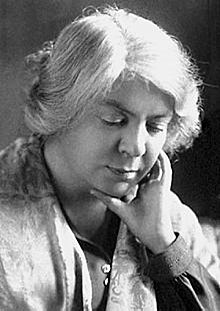Grazia Deledda
| Grazia Deledda | |
|---|---|
 |
|
| Born |
28 September 1871 Nuoro, Italy |
| Died | 15 August 1936 (aged 64) Rome, Italy |
| Occupation | Writer, novelist |
| Nationality | Italian |
| Literary movement | Realism, Decadence |
| Notable awards |
Nobel Prize in Literature 1926 |
|
|
|
| Signature | |
Grazia Maria Cosima Damiana Deledda (Italian pronunciation: [ˈɡrattsja deˈlɛdda]; Sardinian: [dɛˈlɛɖɖa]; 28 September 1871 – 15 August 1936) was an Italian writer who received the Nobel Prize for Literature in 1926 "for her idealistically inspired writings which with plastic clarity picture the life on her native island [i.e. Sardinia] and with depth and sympathy deal with human problems in general". She was the first Italian woman to receive this honor.
Born in Nuoro, Sardinia, into a middle-class family, she attended elementary school and then was educated by a private tutor (a guest of one of her relatives) and moved on to study literature on her own. She started writing at a very young age, inspired by the Sardinian peasants and their struggles.
The first novel she wrote and published was Fiori di Sardegna (Flowers of Sardinia). This novel was published in 1892. She first published some pieces in the fashion magazine L'ultima moda when it still published works in prose and poetry. Nell'azzurro, published by Trevisani in 1890, might be considered her first work. Her family was not supportive of her desire to write. Her works seemed to focus on portraying harsh realities and difficult lifestyles, combining imaginary and autobiographical elements. Her novels tend to criticize social values and moral norms rather than the people who are victims of such circumstances.
Still between prose and poetry are, among the first works, Paesaggi sardi, published by Speirani in 1896. In 1900, after having married Palmiro Madesani, a functionary of the Ministry of War whom she met in Cagliari in October 1899, the writer moved to Rome and after the publication of Anime oneste in 1895 and of Il vecchio della montagna in 1900, plus the collaboration with magazines La Sardegna, Piccola rivista and Nuova Antologia, her work began to gain critical interest. She had two sons and lived a quiet life occupied by her writing. She was a very prolific writer publishing, on average, a novel a year.
In 1903 she published her first real success, Elias Portolu that confirmed her as a writer and started her work as a successful writer of novels and theatrical works: Cenere (1904), L'edera (1908), Sino al confine (1911), Colombi e sparvieri (1912), Canne al vento (1913) -her most well known book in Italy-, L'incendio nell'oliveto (1918), Il Dio dei venti (1922).
...
Wikipedia
